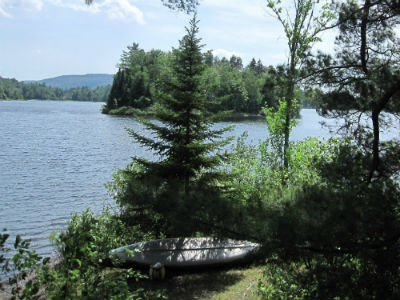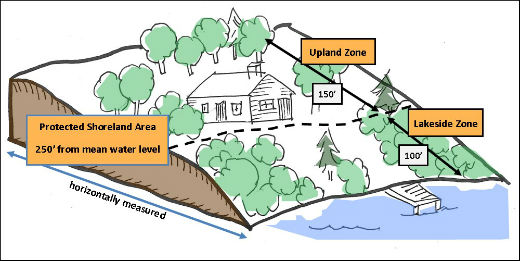 Effective July 1, 2014, the Vermont Legislature passed the Shoreland Protection Act (Chapter 49A of Title 10, §1441 et seq.), which regulates shoreland development within 250 feet of a lake’s mean water level for all lakes greater than 10 acres in size. The intent of the Act is to prevent degradation of water quality in lakes, preserve habitat and natural stability of shorelines, and maintain the economic benefits of lakes and their shorelands. The Act seeks to balance good shoreland management and shoreland development.
Effective July 1, 2014, the Vermont Legislature passed the Shoreland Protection Act (Chapter 49A of Title 10, §1441 et seq.), which regulates shoreland development within 250 feet of a lake’s mean water level for all lakes greater than 10 acres in size. The intent of the Act is to prevent degradation of water quality in lakes, preserve habitat and natural stability of shorelines, and maintain the economic benefits of lakes and their shorelands. The Act seeks to balance good shoreland management and shoreland development.
Any new development, redevelopment, or clearing within 250 feet from mean water level may require a permit or registration. A helpful summary of the Shoreland Protection Act describes the types of activities that are jurisdictional to the Shoreland Protection Act and the standards of the Act. If a shoreland owner proposes a jurisdictional activity, such as tree removal or an expansion of an existing structure, and the standards of the Act cannot be met, the shoreland owner will be required to implement best management practices.

Use the Shoreland Project Worksheet to determine if your residential project needs a permit or registration.
Additionally, The Vermont Shoreland Protection Act: A Handbook for Shoreland Development helps explain the Shoreland Protection Act and the permit or registration process.
Exemptions
The following are examples of projects that do not need to be registered or permitted through Shoreland Permitting.
- Maintenance of existing buildings, gardens, and lawns, without enlarging them.
- Creation of a single six foot wide footpath to access the lake.
- Re-construction of existing impervious areas without increasing or changing the current footprint, such as rebuilding a house, deck, or driveway within the exact same footprint.
- Tree removal and pruning within 100 feet of the mean water level using the Vegetation Protection Standards.
- A permit or registration is not required for projects that qualify under the following transition language: Section. 9 Transition.
- The installation, maintenance, repair, or replacement of a wastewater system or potable water supply permitted by the Agency of Natural Resources is exempt from requiring a Shoreland Permit or Registration. However, all cleared area and/or impervious surface associated with a wastewater or potable water supply system count towards parcel surface area values for cleared area and impervious surface within the Protected Shoreland Area.
Delegated Municipal Authority
It is possible for Shoreland Permitting to delegate permit authority to municipalities as long as the municipality seeking delegation has fulfilled the following requirements (Municipal Delegation Summary):
- Has adopted a bylaw or ordinance functionally equivalent to the shoreland standards.
- Has adequate resources for administration and enforcement of the bylaw or ordinance.
Landowners in delegated municipalities do not need a state shoreland permit for creation of cleared area or impervious surface within the Protected Shoreland Area. Contact the appropriate municipal office for information regarding permitting of projects in the shoreland. The following towns have delegated municipal authority: Burlington, Colchester, Greensboro, and Elmore.
